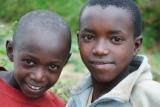Birthday Hike -Nathan
 On my mom’s birthday we went for a hike. We looked at our map of the area and picked a mountain to climb, driving on windy ‘moon dust’ covered roads to get to it.
On my mom’s birthday we went for a hike. We looked at our map of the area and picked a mountain to climb, driving on windy ‘moon dust’ covered roads to get to it.
About a mile before our destination, we saw kids playing football (soccer) on a dirt basketball court. Of course when we stepped out of the car to play, we had a crowd around us. We divided into teams and started to play. They were very good, quick on their feet and good with the ball. During our game, a church service let out and we had another crowd, laughing, pointing and smiling at us as we played. We must have looked funny.

After some time some kids brought out 2 spinning tops. They whipped the tops with a string (strip of cloth) tied to a stick. The spinning top itself was an upside-down cone, a little smaller than my fist, whittled from a piece of wood. Each time they whipped the top, the string made a snap when it wrapped around the top, and set it spinning. Each kid took turns whipping the top until it stopped. When we tried we found it was a lot harder than it looked; my brothers and I, whipped the dirt more than the top at first, but soon we got the hang of it. While we were playing, mom and dad were talking with the high school students from the school next door. They were laughing.

 We played with the kids for a while longer before we started our hike. As I walked away, one of the kids came to me saying “Gift for me” (meaning ‘gift for you’) and handed me the spinning top!! I was honored by his generosity, and thanked him in my beginner Kinyarwanda.
We played with the kids for a while longer before we started our hike. As I walked away, one of the kids came to me saying “Gift for me” (meaning ‘gift for you’) and handed me the spinning top!! I was honored by his generosity, and thanked him in my beginner Kinyarwanda. The hike took us to a small peak.

The peak was practically next to the road, but we followed a small trail winding its way around the hillside to many houses. At each of the houses kids came running to join us. We stopped for lunch at a point overlooking the valley, gave each kid a piece of bread, and ate together. I took out the spinning top, and the kids immediately asked if they could try. (Spinning tops were probably one of the favorite toys of EVERY kid!!) They were very good at it, and each time we came to a flat spot on the trail, they begged me to have a try.
We continued on around the hillside, walking over a patchwork quilt of cultivated landscape—maize (corn), beans, carrots, cabbage, sorghum, wheat, pineapple, cassava, sweet potatoes, Irish potatoes, and flowers.
 |
| sorghum |
 |
| cabbage |
 |
| maize (corn) |
 |
| wheat |
 |
| flowers |
We even saw for the first time rosemary, thyme, and a strawberry patch. We would not have seen the strawberries except the kids led us to it. We pulled out our lunchboxes and filled them to the brim with small sweet strawberries. Mom picked rosemary and thyme for her garden at home.
Near the peak we came to a small eucalyptus forest. (These trees are grown for their tall straight wood and are also used whole in the framework of mud huts.) The air in the forest smelled very clean and sweet, unlike the fumy air in the city.
 On the other side of the forest we climbed up to the high point and could see the road again. As we gathered by the car at the end of our hike the kids played with the spinning top until we had to go; they sure loved it!!
On the other side of the forest we climbed up to the high point and could see the road again. As we gathered by the car at the end of our hike the kids played with the spinning top until we had to go; they sure loved it!!





























































